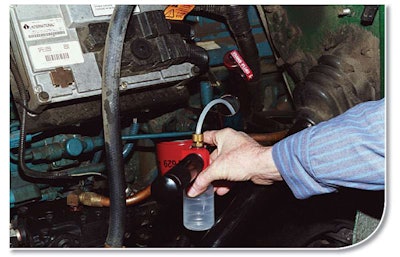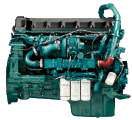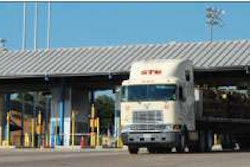Most manufacturers have yet to extend change intervals, but oil seems to thrive in the new engines.
Almost two years after the introduction of 2010 engine technology, the anticipated oil change extensions are mostly missing. The only exception, ironically, is Navistar, the one engine maker that chose to use exhaust gas recirculation without selective catalytic reduction to kill nitrogen oxides (NOx). The manufacturer improved filtration on some engines to make extending changes from 25,000 to 40,000 miles practical.
 Any drain extension beyond factory- recommended intervals should be made only when oil samples are analyzed and properly interpreted, and when there is little or no variation in the truck’s operation.
Any drain extension beyond factory- recommended intervals should be made only when oil samples are analyzed and properly interpreted, and when there is little or no variation in the truck’s operation.Still, engine makers may loosen up their conservative intervals eventually. In the meantime, oil samples have shown some subtle changes since 2010. Today’s oils are better at handling increased heat, and they show reduced soot, which may extend oil life.
The expectation for extended drains has to do with the nature of SCR. The additional weight and complexity of the SCR system were justified based on higher engine efficiency, as well as the higher NOx levels in the exhaust, which would burn soot and almost eliminate active regeneration of the diesel particulate filter. This meant better fuel economy. Given that SCR engines would need much less EGR, the hope was they’d provide truck operators with a bonanza of extended change intervals, and thereby big savings in oil and filter costs.
While that’s a way off, Mack, Volvo and Cummins say they’ve seen changes in TBN [total base number] levels and oxidation rates in oil samples since 2010. Cummins has noticed a reduction in soot levels.
 The EGR line on this 2010 Cummins ISX (right) is smaller than before, and the Volvo D13 (left) also has a small EGR passage because, with SCR, significantly less exhaust needs to be recirculated. Having less EGR reduces many of the stresses on engine oil.
The EGR line on this 2010 Cummins ISX (right) is smaller than before, and the Volvo D13 (left) also has a small EGR passage because, with SCR, significantly less exhaust needs to be recirculated. Having less EGR reduces many of the stresses on engine oil.For Mack, already low levels of soot did not change between the 2007 and 2010 engine technology changes required to meet U.S. Environmental Protection Agency emissions mandates, says company Director of Powertrain Marketing David McKenna. Reducing the EGR flow rate and improving combustion quality, he notes, can account for this.
Volvo Powertrain Director Ed Saxman, echoing McKenna, notes the 2010 engines have “yielded a minimal increase in oil oxidation, but not to the extent that it would affect performance. Also, we found that the prolonged high temperatures in EPA ’10 engines have had no effect on oil performance and do not affect drain intervals. Overall, the oil analysis report looks very similar between ’07 and ’10 equipment.”
Cummins attributes reduced soot levels to boosted precision in the company’s fuel-injection process, accomplished through the XPI common rail system, says Zack Ellison, director of customer technical support. “However,” he adds, “we have also probably slightly increased the TBN depletion and oxidation rates in most 
When it comes to fuel economy, diesels thrive on high maximum cylinder temperatures. The higher piston temperatures are a result of tuning done with 2010-11 engines equipped with SCR to help optimize fuel economy.
Reduced soot levels in the oil sump extend oil life, says Chevron Lubricants Commercial Sector Manager Len Badal. “Furthermore, with some of the newer 15-liter engines such as the Detroit Diesel DD15 engines and others, they have larger oil sumps, which are allowing for potentially longer oil change intervals than previous model engines, since there is more oil capacity to help manage soot and control acid buildup.”
With Detroit Diesel and Navistar’s MaxxForce Big Bore engines, no change extensions are recommended, say Daimler Trucks’ Brad Williamson and Navistar’s Tim Shick. However, those manufacturers already have long change intervals relating to premium filtration for over-the-road trucks – 40,000 miles for Navistar, and what Williamson calls an “industry leading” 50,000 miles for Detroit.
Mack, Volvo and Cummins officials are optimistic intervals may be increased.
Ellison notes other favorable factors with Cummins’ 2010 and later engines. These include the more thorough change made possible with the new engines. Two to three more quarts of oil can be drained and replaced because the injector camshaft – whose bushings retained oil – has been removed on the 2010 engines because of the XPI fuel system.
“There is work going on at Cummins all the time relating to the possibility of extending drains,” he says. “But measuring what goes into the oil and its degradation rate is a major project.” Ellison also says Cummins and other engine makers are “pretty conservative because you need to have an extremely high confidence level before you can make such a change.”
Manufacturers are hesitant to adopt extended intervals for good reasons. One is that “the truck doesn’t always show up exactly at the right time” for a scheduled change, Ellison says. Delaying the change 5,000 miles can lead to problems. Also, even a subtle change in the way a truck operates can make an extended interval inappropriate.
“Any interval that would take an operator past the OEM recommendations need to be very closely watched and monitored through used oil analysis,” Badal says. “With extended intervals, it is also helpful to ensure that premium products are used throughout the truck.”
With engines having produced a significant reduction in most stresses with 2010 technology, some helpful drain interval extensions may yet be introduced as more experience is gained.









